ERA Country Report 2023
Israel
Edited by Jan Wynarski (Ecorys)
as part of ‘Development of the ERA Scoreboard, the ERA Dashboard and the Regular Reports’ project for the European Commission, Directorate-General for Research and Innovation under Framework Contract N° 2018/RTD/A2/OP/PP-07001-2018 Lot 2 (EDAR)
Click here to download this country report![]()
- Table of contents
-
ERA Country Report 2023: Iceland
1. National context
1.1. Overview of the ERA policy agenda implementation
1.2. Policy context
2. Assessment of the Implementation of the ERA Policy Agenda and ERA Priorities
2.1. ERA Priority 1: Deepening a truly functional internal market for knowledge
2.2. ERA Priority 2: Taking up together the challenges posed by the twin green and digital transition and increasing society’s participation in the ERA
2.3. ERA Priority 3: Amplifying access to research and innovation excellence across the Union
2.4. ERA Priority 4: Advancing concerted research and innovation investments and reforms
3. Country-specific drivers and barriers
4. Final remarks
5. Bibliography
6. Annexes
6.1. Annex 1: Graphs
ERA Country Report 2023: Israel
|
Key takeaways:
|
1. National context
1.1. Overview of the ERA policy agenda implementation
The latest available data for the European Innovation Scoreboard (EIS) shows Israel as a moderate innovator in 2022 at 96.4% of the EU average. Israel as an Associated Country has committed to three ERA actions: 1) Action 1: Enable Open Science, including through the European Open Science Cloud (EOSC); 2) Action 8: strengthen research infrastructures; and 3) Action 12: accelerate the green/digital transition of Europe’s key industrial ecosystems.
The Ministry of Innovation, Science and Technology announced in 2022 the top five R&D priorities: Bio-convergence (which merges engineering and medicine), foodtech, renewable energies and energy storage, civilian space industry and bluetech (the sea as a national resource). The Ministry's research grants fund distributes EUR 45.5 million a year and will place significant emphasis on the national priority areas. These areas are mainly related to ERA Priority 2: Taking up together the challenges posed by the twin green and digital transition and increasing society’s participation in the ERA and are addressed by specific national initiatives surrounding the aforementioned fields. The Israeli government will promote national programs in the selected areas, addressing such aspects as infrastructure, regulation, research investment, etc. ^
1.2. Policy context
The Ministry of Innovation, Science and Technology is responsible for Israel’s public investment in scientific research and serves as a link connecting academic research with industrial development. It aims to improve knowledge and research infrastructure to maximise the benefit of Israeli research. In 2023, the Ministry established a national knowledge centre for research infrastructures, which connects all researchers and relevant experts throughout the country to enhance collaboration within the system. ^ Additional government bodies also play a role in Israel’s R&I sector. The Council for Higher Education (CHE), established in 1958, is the state body responsible for higher education in Israel and sets the policy for the state's higher education system.
The Israel Innovation Authority (IIA) is the main public agency promoting industrial research and development. Its mission is to cultivate and develop the innovation potential in Israel while improving research infrastructures and strengthening the structure for a knowledge-based industry. In 2019, the IIA launched an Artificial Intelligence (AI) R&D Framework and Activities to create a knowledge facility to support the Israel´s position in the field of artificial intelligence (AI).
Moreover, the Israel Science Foundation (ISF) is the major body funding basic research in the country. It is mainly funded by the government via the Planning and Budget Committee of the Israel Council for Higher Education. ^ Similarly, the National Infrastructure Forum for Research and Development involves representatives from the national relevant ministers for R&I to plan and budget the national funds for innovation. ^
In the field of military technology, the Directorate of Defence Research & Development at the Ministry of Defence is responsible for developing innovative concepts for defence, guiding R&D policy for the Israeli defence establishment, and creating international technological collaborations. Operating under the Ministry of Defence, the Unit for Research and Technology Infrastructure is a scientific research organisation that focuses on upgrading infrastructure and testing facilities of security and defence matters.
In addition to the national institutions, the government has adopted quantitative targets to promote green and technological innovation. These objectives are mainly related to ERA Priority 2 and aim to implement new methods and increase investment in sustainable innovation. ^ The Prime Minister’s Office established a national climate calculation centre in 2022, supporting research in climate change. An annual amount of 1 million EUR will be allocated for the period 2023-2027 to establish the computing centre and the database to monitor the progress, which is financed by the Meteorological Service of the Ministry of Transport and Road Safety. ^
A strong focus of Israel’s R&I policy lies in technology. To address the importance of digitalisation and the technological transition, the Israeli Parliament passed the Law for the Promotion of Knowledge-Intensive Industries in July 2023. It introduced new tax incentives to encourage investments in hi-tech. ^ In October 2023, the Finance Ministry unveiled a substantial funding expansion for the Israel Innovation Authority's Fast-Track program aimed at shoring up the country's hi-tech sector during a period of uncertainty. The funding of the programme is expected to assist start-ups grappling with financial challenges. ^ The implementation of these initiatives to promote R&D in scientific and technological fields was preceded by the National Infrastructure Forum for Research and Development (TELEM) established in 1997 by the National Academy of Science. It started an initial discussion to enhance R&I through the promotion of international cooperation and the establishment of national research infrastructures in Israel.
2. Assessment of the implementation of the ERA Policy Agenda and ERA Priorities.
Chapter 2 has two objectives: 1) It qualitatively assesses the state-of-play of the implementation of the ERA Actions that Greece has committed to. The qualitative information primarily stems from the OECD STIP survey 2023, supplemented by further desk research; 2) It quantitatively assesses the country’s progress towards achieving the ERA priorities as set out on the Pact for Research and Innovation in Europe. The presented quantitative information is mainly based on the ERA Scoreboard and ERA Dashboard indicators, and covers longer-term trends since 2010. Additionally, general indicators for the overall R&I system are outlined in Table 1. More detailed information on the data and graphs can be found in Annex 1. This report will serve as a baseline for reporting in the future.
|
Indicator |
Most Recent Metric |
|
Gross Domestic Expenditure on R&D (GERD) as a percentage of GDP |
5.44 (2020) |
|
Government Budget Allocations for R&D (GBARD) as a share of GDP |
0.68 (2020) |
Source: compiled by research team based on the ERA Scoreboard and ERA Dashboard indicators
2.1. ERA Priority 1: Deepening a truly functional internal market for knowledge
2.1.1. State of play in the implementation of the ERA Actions
In relation to the ERA Action 1: Enable the open sharing of knowledge and the re-use of research outputs, including through the development of the European Open Science Cloud (EOSC), Israel is part of the European Open Science Community. The Israel Science Foundation is an overserving member of the European Open Science Association, and some Israeli universities are engaged in promoting an open science policy in Israel. It takes the form of a new and alternative publishing venue called the ISF gateway. An innovative open-access publishing platform offering rapid publication and open peer review whilst supporting data deposition and sharing. ^
The Bar Ilan University joined OPEN AIRE in 2018, leading the effort to promote open science in Israel and operating a National Open Access Desk ^. OpenAIRE is a Non-Profit Partnership of 50 organisations to ensure a permanent Open Science infrastructure in Europe. On 19 November 2019, the first Israeli national workshop took place, which raised awareness and laid the ground for a community of support for Open Science within Israel. ^
Regarding ERA Action 8: Strengthen sustainability, accessibility, and resilience of research infrastructures in the ERA, the Ministry of Innovation, Science and Technology established in 2023 a national knowledge centre for research infrastructures, which will connect all researchers to research equipment and relevant experts throughout the country. The mission is to promote collaborations that maximise the potential of all Israeli research infrastructure to benefit of the Israeli scientific ecosystem (academia, hospitals, and industry).
The Israel Innovation Authority coordinates the Incentive Programme to Encourage the Establishment of R&D centres by multinational companies in biotechnology and health. This incentive programme enables large foreign industrial companies active in biotechnology or health to establish or expand their R&D and technological innovation activities and their management and global value chain activities in these fields. The programme also aims to increase the number of employees employed by the company in Israel, including non-R&D employees. ^ Similarly, the R&D Infrastructure and Equipment Incentive Programme, also coordinated by the Israel Innovation Authority, enables the establishment and joint operation of R&D infrastructure for industry through a user association, or by subsidising R&D equipment for service providers, thus providing access to the equipment for Israeli industry. ^
Regarding the knowledge centre, all research institutions in the academy and high-tech industry nationwide will collaborate through Israel-Cores.org, a national database that any researcher can access. The database makes information on research-supporting infrastructures in Israel easily accessible to any potential user. At the same time, professional networks are established that connect all experts and service providers in the various research infrastructure centres by field. ^
2.1.2. Progress towards achieving ERA Priorities
With regard to progress towards Sub-priority 1.1: Open science, in 2009, 40% of scientific publications with digital object identifier were open access in Israel according to the indicator share of publications available in open access. This share decreased to 37% in 2019 (Figure 3 in Annex 1). Regarding Sub-priority 1.3: Gender equality, equal opportunities for all and inclusiveness, the share of women in grade A positions in higher education institutes has risen from 13.8% in 2010 to 19.5% in 2018 (Figure 4 in Annex 1). Further, the proportion of papers with mixed gender authorship also increased over the period of 2010 to 2020 from 48.6% to 56% (Figure 5 in Annex 1). However, the proportion of women in authorships of the top 10% most cited publications remained largely stagnant from 2010 to 2018 around 30% (Figure 6 in Annex 1).
Concerning Sub-priority 1.5: Knowledge valorisation, the number of PCT patent applications divided by GDP in million euros was at 0.009 in 2010 and decreased to 0.007 in 2015 (Figure 7 in Annex 1). In terms of Sub-priority 1.6: Scientific leadership, the Academic Freedom Index in Israel has been consistently high since 2010. With a maximum value of 1, the value has stayed between 0.94 in 2010 and 0.93 in 2022 (Figure 8 in Annex 1). The number of scientific publications among the top-10% decreased in Israel from 11.2% in 2010 to 8.6% in 2020 (Figure 9 in Annex 1).
In relation to Sub-priority 1.7: Global engagement, the number of international co-publications with non-EU partners per 1,000 researchers in the public sector increased in Israel between 2012 and 2022 from 977.4 to 1,271 (Figure 10 in Annex 1). Additionally, European and international co-patenting in EPO applications at national level in Israel was at 888 in 2010 and sank to 749 in 2013 (Figure 11 in Annex 1).
2.2. ERA Priority 2: Taking up together the challenges posed by the twin green and digital transition and increasing society’s participation in the ERA
2.2.1. State of play in the implementation of the ERA Actions
In relation to ERA Action 12: Accelerate the green/digital transition of Europe´s key industrial ecosystems, to help government regulation adapt to rapidly changing technologies, the World Economic Forum founded the network of Centres for the Fourth Industrial Revolution. This network aims to create and share knowledge, experience and best practices related to innovative technology regulation by establishing collaborations between governments, leading corporations, the private sector and experts worldwide.
In August 2019, Israel’s Innovation Authority established the Israeli Centre for Regulation of Innovative Technologies, which serves as an Affiliate Centre in the network of Centres for the Fourth Industrial Revolution. The government has adopted quantitative measures and targets to promote technological innovation and capitalise on and enhance the high-tech industry in Israel for the fight against climate change. ^ Climate-tech is one of the growing sectors with increasing private investments going into this sector. 67% of venture capital investments in Israel are in the fields of fintech, IT, and cybersecurity, making Israel a frontrunner in the digital transition when it comes to the latter sectors. ^
2.2.2. Progress towards achieving ERA Priorities
Regarding Sub-priority 2.1: Challenge-based ERA actions, the indicator OECD patents on environment technologies shows that the number of patents has decreased from 8.45 in 2010 to 5.51 in 2019; however, there was fluctuation in the trend over the years (Figure 12 in Annex 1). Linked to the Sub-priority 2.3: Synergies with sectorial policies and industrial policy, in order to boost innovation ecosystems, the direct government support and indirect government support through R&D tax incentives as a percentage of GDP indicator is 0.1351 in 2010 and decreased to 0.1042 in 2020 (Figure 13 in Annex 1).
With regard to the Sub-priority 2.4: An active citizen and societal engagement in R&I in all its dimensions the indicator on research of social innovation per million population indicates that this research is under-developed in Israel. Between 2010 and 2021 publications on social innovation or social entrepreneurship have steadily been at levels of 0.23 (2017) or lower (Figure 14 in Annex 1).
2.3. ERA Priority 3: Amplifying access to research and innovation excellence across the Union
2.3.1. State of play in the implementation of the ERA Actions
Israel has not committed itself to any ERA Actions under this priority. Nonetheless, there is cooperation with the EU under the Horizon Programme and with individual EU Member States. The Israel-Europe R&D Directorate is an inter-ministerial directorate, established by the Israeli Ministry of Economy, the Planning and Budgeting Committee of the Council for Higher Education, the Ministry of Science and Technology, the Ministry of Finance and the Ministry of Foreign Affairs. ^ The aim of the directorate is to promote the participation of Israeli entities in R&D ventures within the European Research Area. ^
2.3.2. Progress towards achieving ERA Priorities
Regarding Sub-priority 3.1: More investments and reforms in countries and regions with lower R&I performance, the increase of total R&D expenditure as a percentage of GDP has always been positive except for 2013 and 2021 within the period 2011-2021. The highest increase could be observed in 2020 at +0.49 (Figure 15 in Annex 1).
2.4. ERA Priority 4: Advancing concerted research and innovation investments and reforms
2.4.1. State of play in the implementation of the ERA Actions
Israel has not committed itself to any ERA Actions under this priority. Nonetheless, there are important initiatives and actors to highlight under this section. The Israel Innovation Authority has several programmes aimed at entrepreneurs, start-ups, and venture capital such as the Tnufa Incentive Program, R&D Collaboration with Multinational Corporations Program and the Technological Innovation Incubators Program. ^
2.4.2. Progress towards achieving ERA Priorities
In relation to Sub-priority 4.1: Coordination of R&I investments, the share of public R&D expenditures financed by the private sector (Figure 16 in Annex 1) shows the evolution of Israel, that increased from 2010 to 2014 and, after some fluctuations, it has constantly decreased since 2016.
3. Country-specific drivers and barriers
The main drivers for the implementation of the ERA Policy Agenda in Israel are relatively high business spending on R&D and the gross domestic spending on R&D as a percentage of GDP, which are the highest in Israel compared to other OECD Countries. ^ Over recent years, there has been a notable increase in start-ups originating from academic institutions. It has provoked debate on whether such a route is preferred to patenting and licensing data to existing firms as a more effective method to facilitate technology transfer from academia to industry. ^
Most government support for human resources for research and innovation is aimed at increasing employment in the high-tech sector. However, other sectors could also benefit from human capital specialised in R&D. There is ongoing debate about whether policies should be better suited to encouraging employment in industries other than high-tech. ^ Closing these gaps can boost productivity growth and reduce the large productivity gap between the high-tech sector and the rest of the economy. The authorities actively promote R&I through favourable tax treatment of intellectual property expenditure and income, as well as direct support measures (e.g. R&I grants). ^
Finally, Israeli high-tech depends almost entirely on the private sector and foreign investors. Israel is the only OECD member in which private and public entities outside the country fund more than half of all R&D performed in the private sector. This makes R&D investments highly dependent on the private sector and foreign investors. ^
4. Final remarks
Although Israel is committed to only three ERA actions, the national research environment aligns highly with the ERA Policy Agenda. It is mainly due to the Israeli government’s priorities on sustainability, digitalisation, research and innovation, initiatives such as the national climate calculation centre or the Israel Innovation Authority's Fast-Track program, which have strengthened the country´s R&I system.
Concerning ERA Priority 1, Israel has made important steps to connect all researchers to research equipment and relevant experts nationwide by establishing a national knowledge centre for research infrastructures in 2023. The indicators show that progress has been made regarding gender equality, particularly regarding the share of women in academia. Regarding ERA Priority 2, climate tech is one of the fast-growing sectors where significant private investments are directed. However, most indicators discussed in this section show stagnation or decrease over the last decade. When looking at the indicators covered under ERA Priorities 3 and 4, both have been decreasing in recent years.
Overall, the Israeli R&I policy strongly focuses on the high-tech sector. It implies a strong opportunity to contribute to the digital transformation. Traditional sectors, such as manufacturing industries, wholesale and retail trade, and food and accommodation service, are lagging in the digital transformation. ^
5. Bibliography
European Commission (2021). European innovation scoreboard 2021, Publications Office of the European Union, available at, https://data.europa.eu/doi/10.2873/725879
European Commission (2021). European Research Area Policy Agenda, available at: https://research-and-innovation.ec.europa.eu/system/files/2021-11/ec_rtd_era-policy-agenda-2021.pdf
European Commission (2022), European Innovation Scoreboard 2022: Country profile Israel, available at: https://ec.europa.eu/assets/rtd/eis/2022/ec_rtd_eis-country-profile-il.pdf
EY Global (2023). Israeli Parliament approves measures to boost investment in high-tech sector, available at: https://www.ey.com/en_gl/tax-alerts/israeli-parliament-approves-measures-to-boost-investment-in-high
f1000research (n.d.). Israel Science Foundation, available at: https://f1000research.com/gateways/isf/about-this-gateway
Israel Innovation Authority (2018). TELEM (The National Infrastructure Forum for Research and Development), available at: https://innovationisrael.org.il/en/program/telem-national-infrastructure-forum-research-and-development
Israel Innovation Authority (2020). Endless Possibilities to Promote Innovation, available at: https://innovationisrael.org.il/en/sites/default/files/Israel%20Innovation%20Authority%202020.pdf
Israel Innovation Authority (2023). 2023 Annual Report: The State of High-Tech, available at: https://innovationisrael.org.il/en/report/2023-annual-report-state-high-tech
Israel Innovation Authority (n.d.) C4IR Israel, availabeavailable at: https://innovationisrael.org.il/en/department/c4ir-israel
Israel Innovation Authority (n.d.) Venture Captial, available at: https://innovationisrael.org.il/en/collaboration_opportunities/venture-…
Israel Innovation Authority (n.d.). Incentive Program to Encourage the Establishment of Multinational Companies’ R&D Centers in the Fields of Biotechnology and Health, available at: https://innovationisrael.org.il/en/programs/incentive-program-to-encourage-the-establishment-of-multinational-companies-rd-centers-in-the-fields-of-biotechnology-and-health/
Israel Innovation Authority (n.d.). R&D Infrastructure and Equipment, available at: https://innovationisrael.org.il/en/programs/rd-infrastructure-and-equipment/
Israel Science Foundation (2017) ISF history, available at: https://www.isf.org.il/#/isf-history
Israel-Europe Research & Innovation Directorate (n.d) ISERD - Your Gateway to European R&I initiative, available at: https://www.innovationisrael.org.il/ISERD/contentpage/about-us
Ministry of Defense (2018) Unit for Research & Technological Infrastructure https://english.mod.gov.il/About/Innovative_Strength/Pages/Unit_for_Research_%26_Technological_Infrastructure.aspx
Ministry of Foreign Affairs (2022). Ministry of Innovation determines Israel’s national R&D priorities, available at: https://www.gov.il/en/departments/news/ministry-of-innovation-determines-israel-s-national-r-d-priorities-9-sep-2022
Ministry of Innovation, Science and Technology (2018). About Ministry of Science and Technology, available at: https://www.gov.il/en/departments/about/most_about
Ministry of Innovation, Science and Technology (2023). For the first time: Collaboration in research infrastructure between all research institutions in the academy and high-tech industry nationwide, available at: https://www.gov.il/en/departments/news/most-news20230108
Ministry of Defense (2018). DDR&D- Directorate of Defense Research & Development, available at: https://english.mod.gov.il/About/Innovative_Strength/Pages/Directorate-_of_Defense_Research_Development.aspx
National Erasmus+ Office Israel (2021). Council for Higher Education, available at: https://www.erasmusplus.org.il/che/pbc#:~:text=The%20PBC%20is%20a%20committee,issues%20of%20budgeting%20to%20it
OECD (2023). AI R&D Framework And Activities Of The Israeli Innovation Authority. STIP Compass, available at: https://stip.oecd.org/stip/interactive-dashboards/policy-initiatives/20…
OECD (2023). Encouraging Israeli Technological Innovation And Harnessing The High-Tech Industry To Combat Climate Change And Meet National Goals, available at: https://stip.oecd.org/stip/interactive-dashboards/policy-initiatives/20…
OECD (2023). Gross domestic spending on R&D, available at: https://data.oecd.org/rd/gross-domestic-spending-on-r-d.htm
OECD (2023). Improving Scientific Knowledge Base On Climate Change, available at: https://stip.oecd.org/stip/interactive-dashboards/policy-initiatives/2023%2Fdata%2FpolicyInitiatives%2F99997152
OECD (2023). OECD Economic Surveys: Israel 2023 , availablet at: https://www.oecd-ilibrary.org/sites/6036659f-en/index.html?itemId=/content/component/6036659f-en#section-d1e414-a009ec737f
OECD (2023). The Israel Innovation Authority Strategy, available at: https://stip.oecd.org/stip/interactive-dashboards/policy-initiatives/2023%2Fdata%2FpolicyInitiatives%2F16386
OECD STIP (2023). Encouraging Israeli Technological Innovation And Harnessing The High-Tech Industry To Combat Climate Change And Meet National Goals, available at: https://stip.oecd.org/stip/interactive-dashboards/policy-initiatives/2023%2Fdata%2FpolicyInitiatives%2F99997142
OECD STIP (2023). Israel-Europe Research & Innovation Directorate, available at: http://stip.oecd.org/2023/data/policyInitiatives/16383
OpenAIRE (2020). On the way towards Open Science: first Israeli national workshop, available at: https://www.openaire.eu/blogs/on-the-way-towards-open-science-first-national-workshop
OpenAIRE (2020). The Israel Science Foundation (ISF) big step towards Open Science. Available at: https://www.openaire.eu/blogs/the-israel-science-foundation-isf-big-step-towards-open-science
OpenAIRE (2022). Open Science in Europe: Israel, available at: https://www.openaire.eu/os-israel
Tel Aviv University The David and Yolanda Katz Faculty of the Arts (2013). Israel Science Foundation, available at: https://en-arts.tau.ac.il/Researches/prize/inter
The Israel Academy of Sciences and Humanities (2022) TELEM forum, available at: https://www.academy.ac.il/RichText/GeneralPage.aspx?nodeId=859
The Jerusalem Post (2023). Finance Minister bolsters IIA’s tech innovation funding fourfold amidst crisis, available at: https://www.jpost.com/business-and-innovation/article-770248
Weisz Zilberman, Yael (2022). Creating a ripple effect to boost Israel’s climate-tech sector, available at: https://startupnationcentral.org/blog/climatetech/creating-a-ripple-effect-to-boost-israels-climate-tech-sector/
6. Annexes
6.1. Annex 1: Graphs
The 2023 ERA Scoreboard and ERA Dashboard indicators used in the country report are presented in this annex. Detailed information on the data sources, description of the indicators, time period for which the data is available, and the necessary calculations can be found in the ERA Scoreboard and ERA Dashboard Methodology Report. The most recent available data for each indicator has been used.
General Indicators
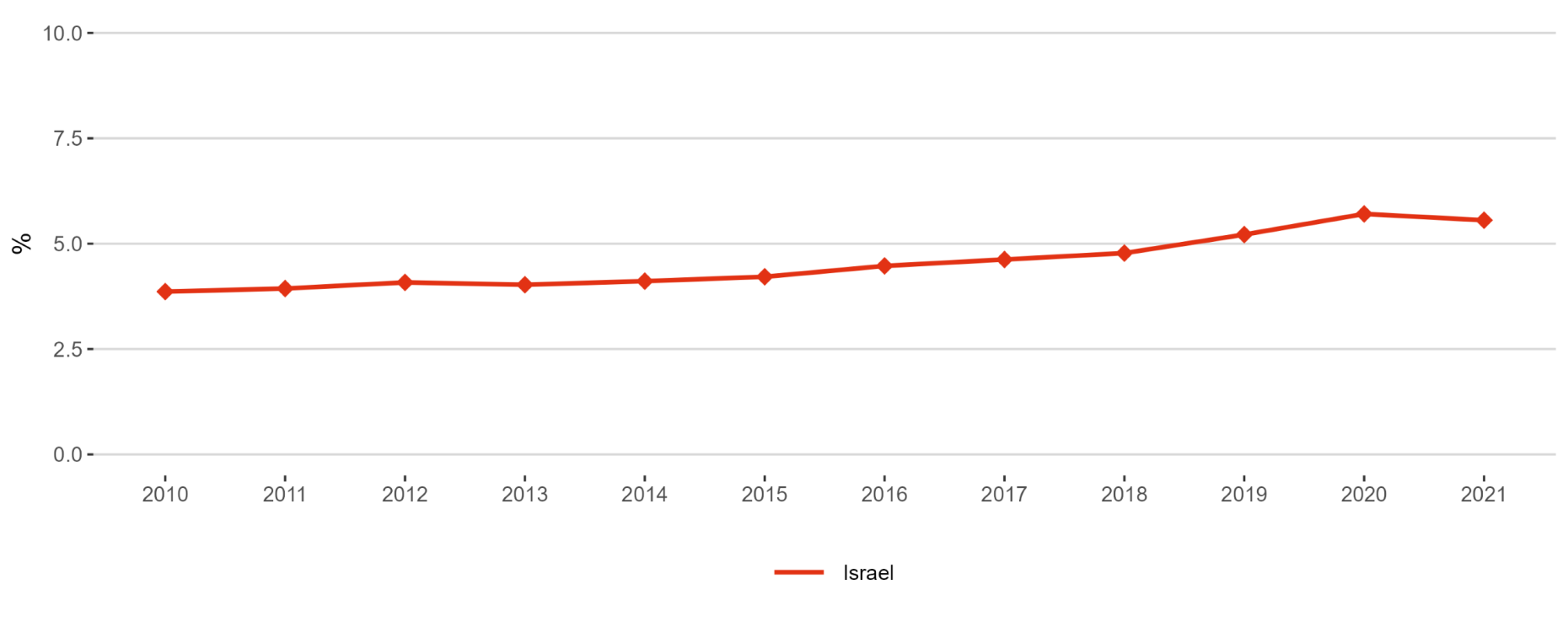
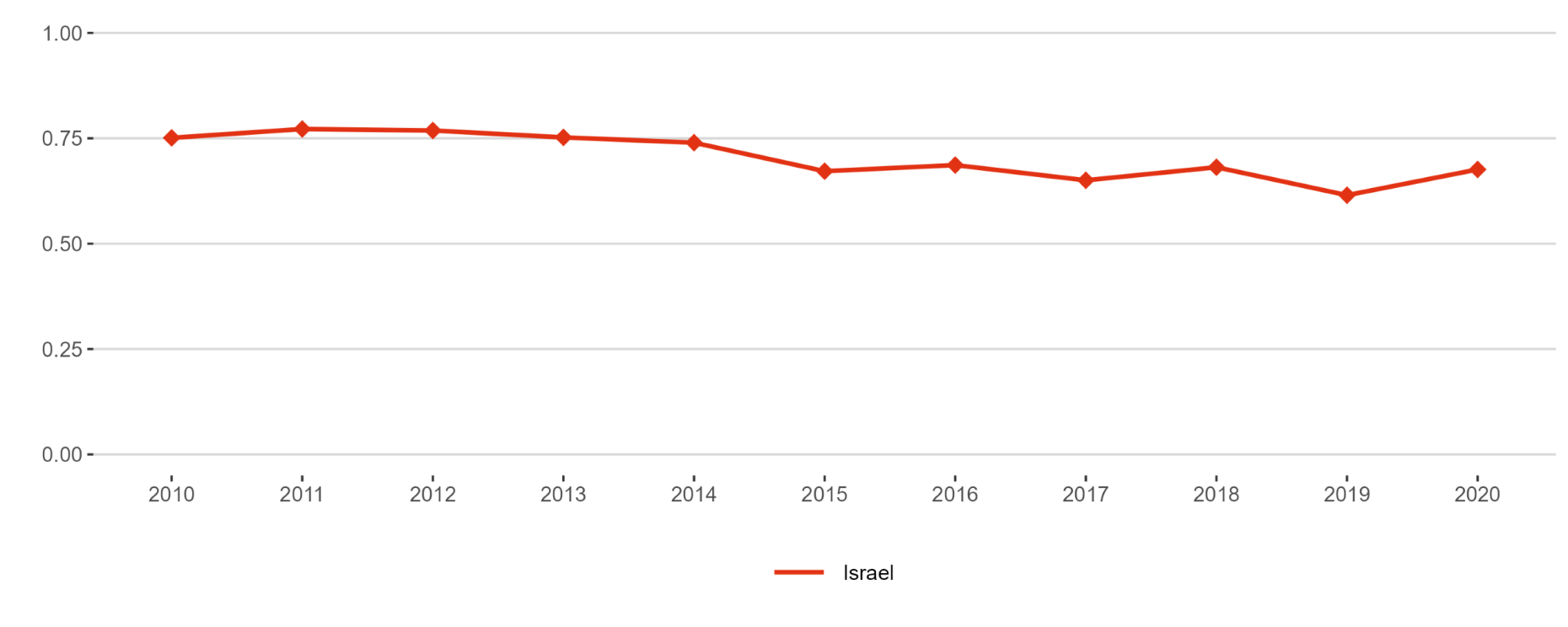
Priority 1: Deepening a truly functioning internal market for knowledge
Sub-priority 1.1: Open Science
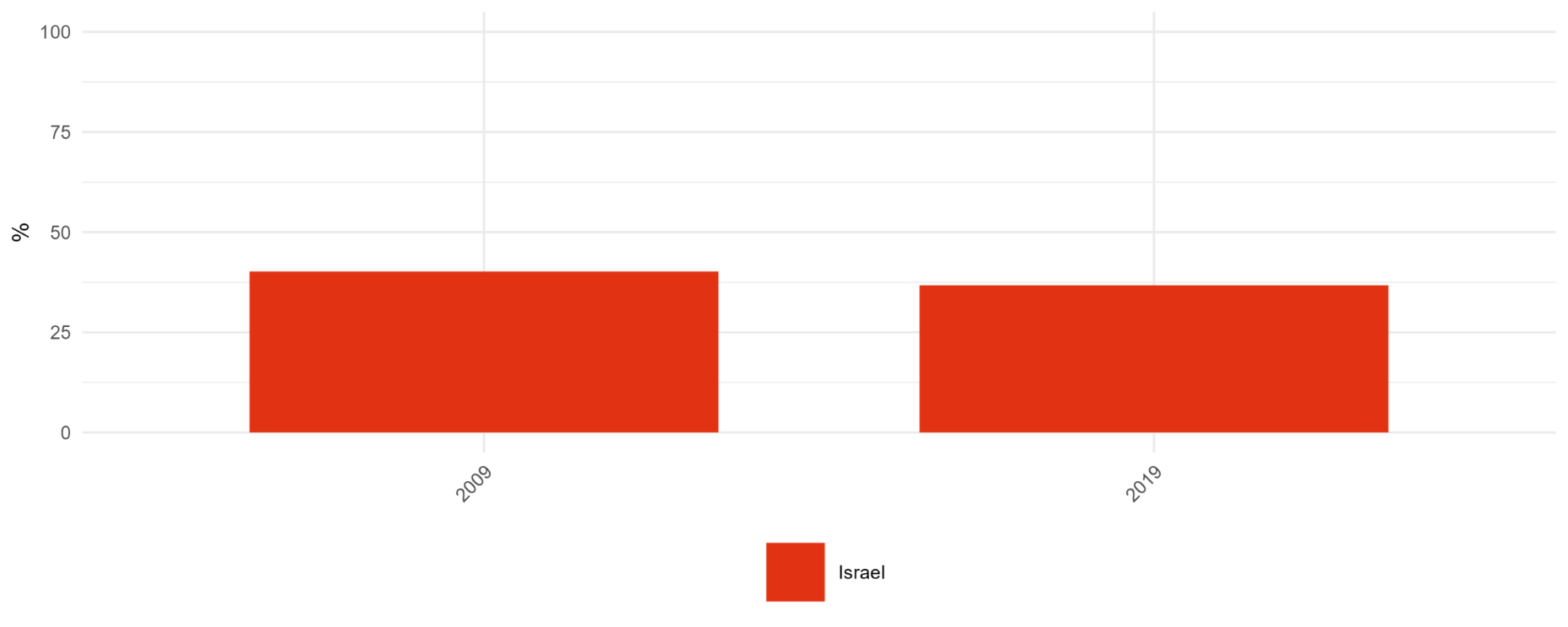
Sub-priority 1.3: Gender equality, equal opportunities for all and inclusiveness
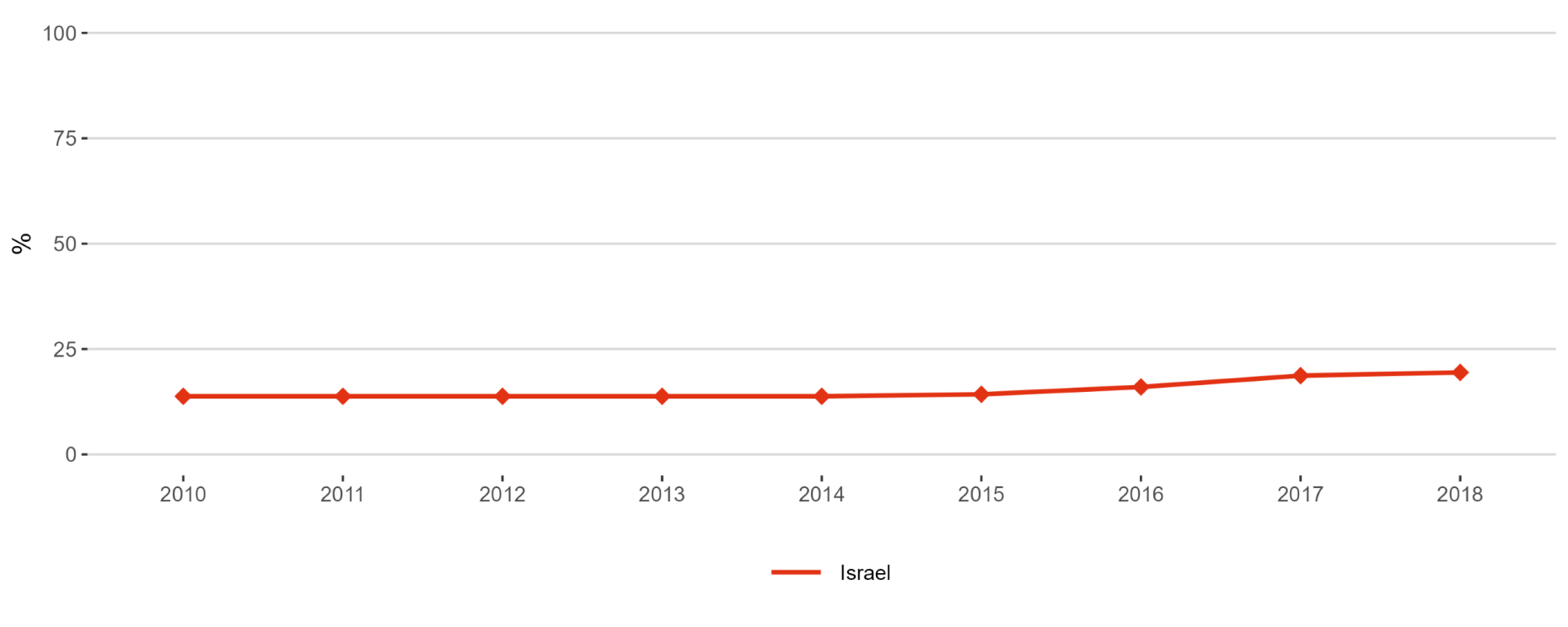


Sub-priority 1.5: Knowledge valorisation
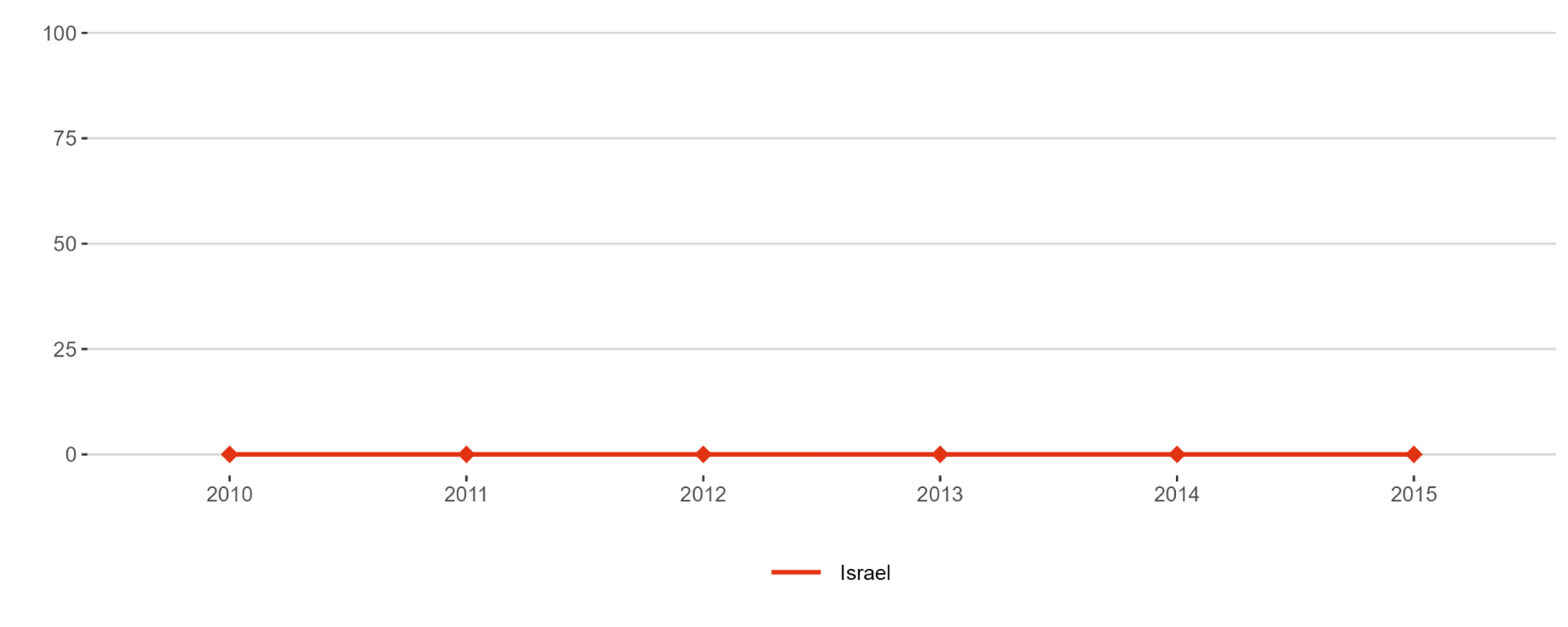
Sub-priority 1.6: Scientific leadership
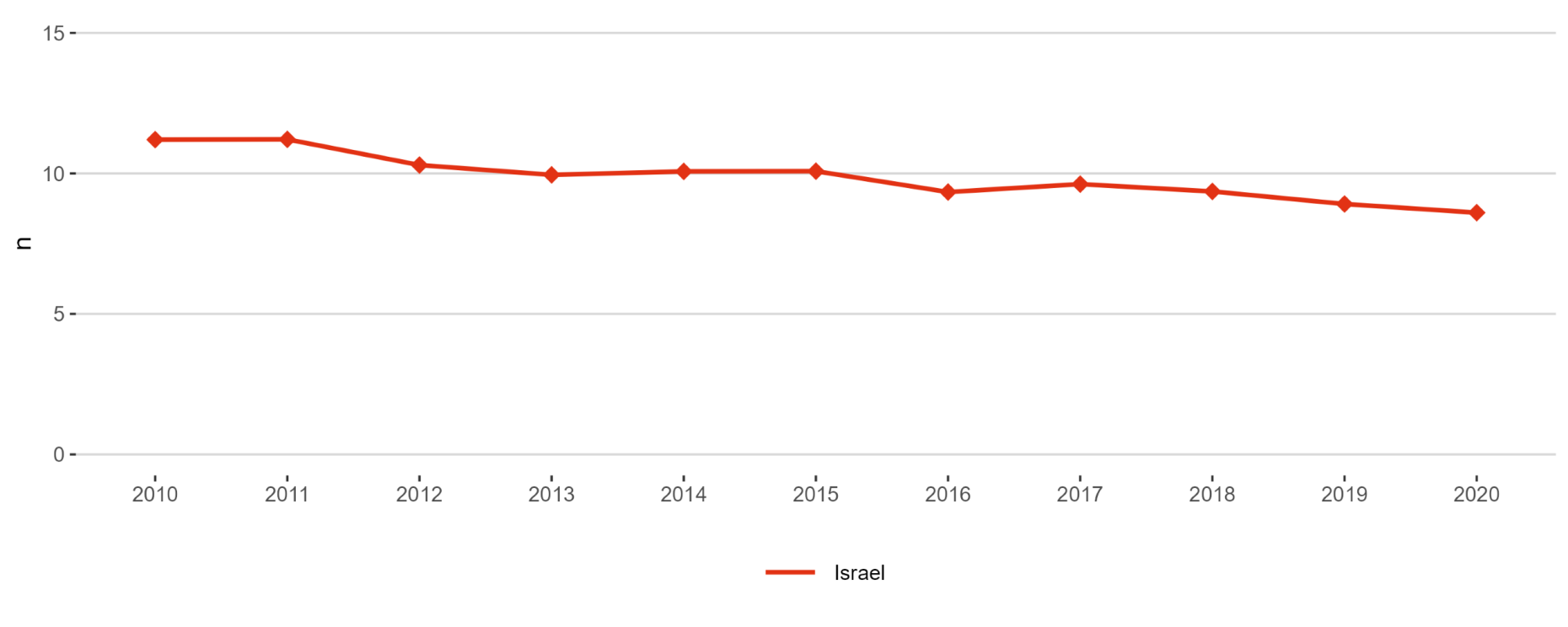
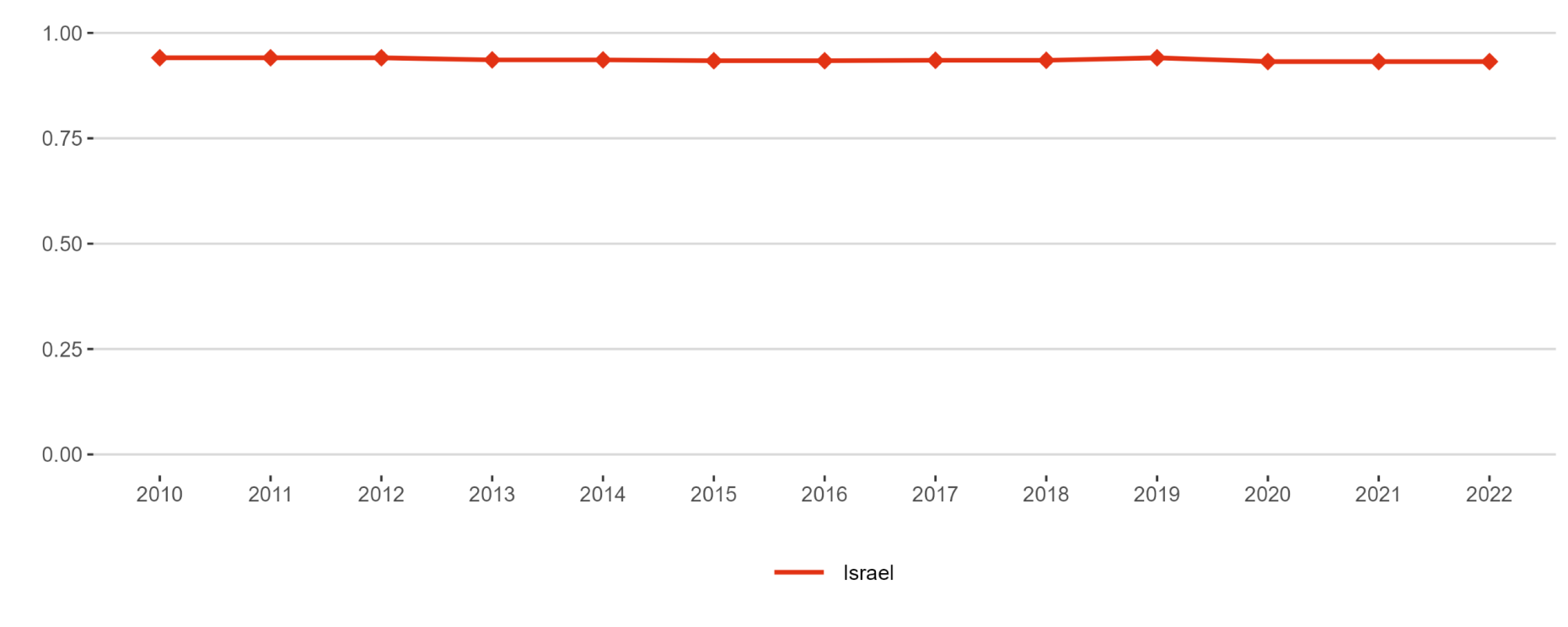
Sub-priority 1.7: Global engagement


Priority 2: Taking up together the twin green and digital transition, and increasing society´s participation in the ERA
Sub-priority 2.1: Challenge-based ERA actions
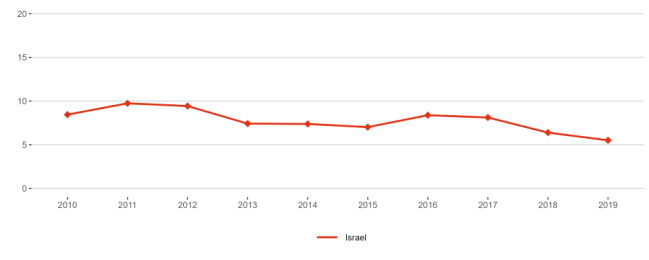
Sub-priority 2.3: Synergies with sectorial policies and industrial policy, in order to boost innovation ecosystems

Sub-priority 2.4: An active citizen and societal engagement in R&I in all its dimensions
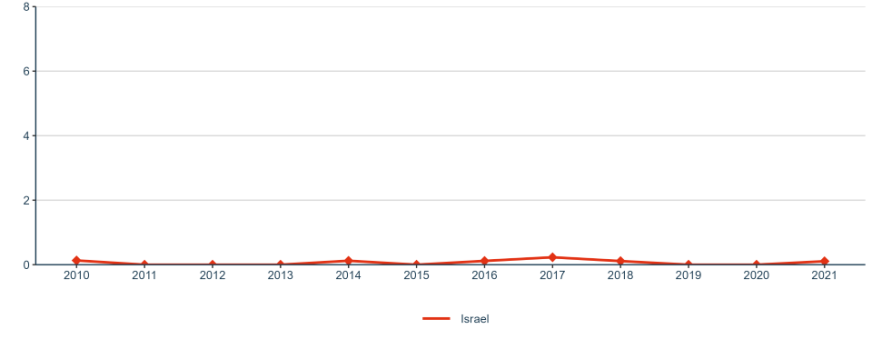
Priority 3: Amplifying access to research and innovation excellence across the Union
Sub-priority 3.1: More investments and reforms in countries and regions with lower R&I performance

Priority 4: Advancing concerted research and innovation investments and reforms

